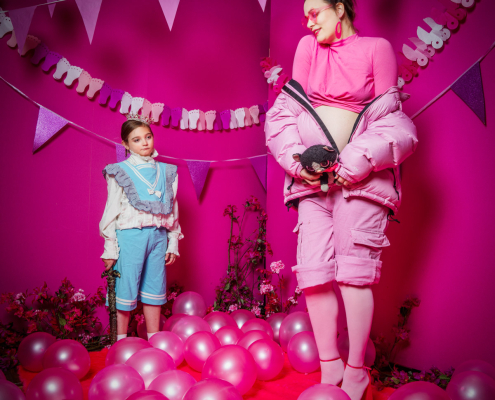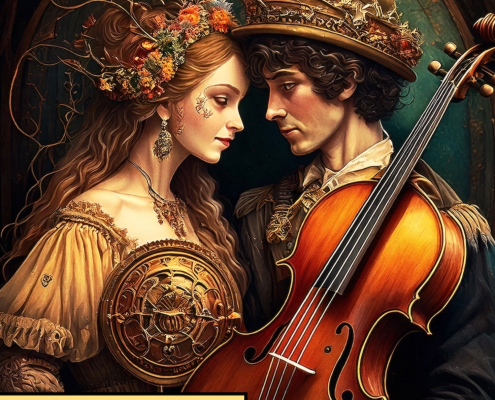
Working with the optical spot from Westcott to create stunning images
When you want to create something different than the standard photo there are a lot of options.
You can add some props, add a nice backdrop, maybe add some smoke and accent lights etc.
But something that will really spice up your shoot is without a doubt an Gobo projector, or optical spot.
In this video tutorial I'm using the Westcott Lindsay Adler optical spot for three completely different sets with our model Lois.

Using loads of flowers in a set for an awesome pregnancy shoot
Today in the blog a video tutorial about using loads of flowers in a set for awesome pregnancy shots, learn the lighting and more

Using a set with a pregnancy shoot
Today in the blog a video tutorial about using a small set during a pregnancy shoot and add a funny element for storytelling

Working with an unique shadow effect
Today in the blog a video tutorial about using unique shadows in a pregnancy shoot and how to setup the lighting

Same set different looks and messages
It's very important
as a photographer to be able to get images that are fitting the client y0ur shooting for.
This can be a product, a model, musician, landscape, building etc.

Using a gobo projector with different colors
Its fun
To experiment with different solutions to get cool looks.
As you probably know I'm a big fan of focussed light sources, and the gobo projector is of course an awesome light shaper that does this and so much more.
The Gobo projector I'm using is the Westcott Lindsay Adler version.

Using a gobo projector in a pregnancy shoot video
Every pregnancy is unique, and when we shoot a pregnancy I always try to find something that is fitting for the model.
We all know Nadine I think and with Nadine it's not possible to just shoot some images of her belly. So during a recent workshop we decided to shoot different setups all aimed at a part of Nadines character and of course my input 😀

model photography tips: Angles, lighting and guitars
Today it's about one of those things that really can make or break a shot, the angle.
When we talk about the angle of a shot we often immediately think about shooting from eye level, ants perspective or the giant perspective.

And now for something completely different digital vs VHS for music
The idea came to test out a device you probably would not expect in a recording setup.
An Hi-Fi stereo VHS recorder.
Now it may seem weird, but it's not.
When I grew up, most music was spread on tapes and even with Dolby noise reduction and great players the sound quality was nothing near the very expensive CDs.
Until we started to experiment with BetaMax and VHS recorders. Especially the Hi-Fi VHS recordings sounded great. Beta was still beter but compared to even the best cassettes this was a huge step forward, and you could get loads of music on one tape.

The highlight of the year, the Wibi Soerjadi concert 2024
Every year has it's up and downs, but for us both as a family and as photographer there is one highlight that stands out.
The Christmas concert in the concertgebouw Amsterdam with Wibi Soerjadi.

So much fun with cheap materials and lights
One of the things I love to experiment with are cheap lighting solutions.
This can be a string of fairy lights, Christmas lighting or a magic lantern.
With modern cameras and great noise reduction in Lightroom or Topaz you can really push the creative limits.

A special Christmas scene with a beautiful background
For me when I think of Christmas I always see a Charles Dicksens like scene, but with more warm tints and of course glowing lights. Let's say a bit Fashion vs Charles Dickens.
During a recent session in our studio I joined the group for the last setup in building a small set with a Christmas tree.

Merry Christmas
Today we wish you all a merry Christmas via a personal message.

Working with a scenic backdrop tutorial video
today in the blog a tutorial about using scenic backdrops in a set and using continuous lighting to add some extra mood.

How to create depth in a scenic backdrop set
Using a scenic backdrop can be great on its own, but when. you want to add some real depth the image... well in this blogpost I share some tips and examples.

A quick test shoot
For the workshops we are always looking for new models, and sometimes you find someone via the net/social media, in a restaurant or in your own studio 😀
Janice as modelling for friends of us and I could not resist to also shoot some images. And guess what... she lives close by so she will probably pop up more regularly during the workshops in 2025.

Focus your light
Shadows can be tricky when you start out but in the end it's the glue that sticks everything together and makes an image look more realistic and also creates depth. Of course we need light to create shadows, and the smaller the light source the faster the edge transfer (difference between shadow and light). In other words smaller light means sharper shadow edges.

How to very easily find out your flash duration
One of the things I always love to do during photoshoots is adding some motion to the shots.
Now if you ever tried this you will probably know it's all about timing, but even than you probably noticed that sometimes the images are razor sharp and sometimes maybe a bit blurred, how is this possible when you use the same strobes?

Are you really that “shallow” ?
This also means that when I see someone responding on an add using my images or videos I try to help out and reply, but sometimes it's getting really weird, and because I hate to repeat myself 1000x I thought it would be fun and frustrating (if you are one of those) blog post about some of the weirdest conversations I had about Topaz PhotoAI.

Black Friday offers from our partners 2024
Black Friday Deals 2024
For our Dutch audience, we…

